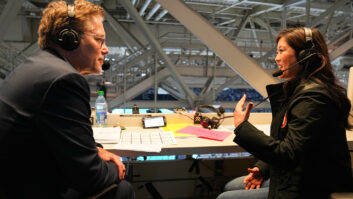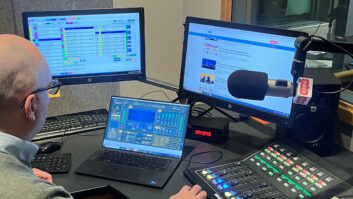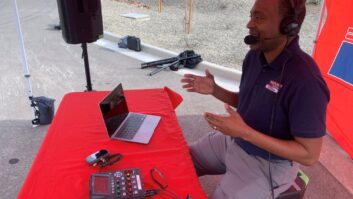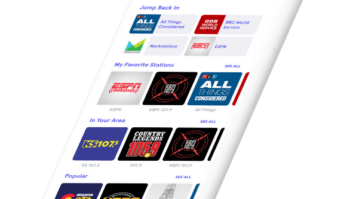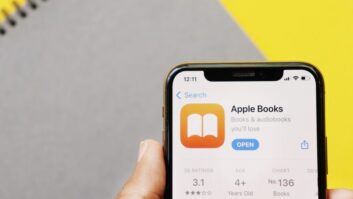
Burk app helps with facility control. Wouldn’t it be great if they invented something like the laptop, only smaller, that fit into your pocket for when you needed to feed a news report back to the studio? Or, change automation settings while you’re sitting at a restaurant?
Maybe make a phone call?
Oh wait, they have. That hunk of silicon with the powerful user interface we call the smartphone has become a handy app dispenser for all kinds of radio uses.
Two years ago, we could count on one hand the number of smartphone apps for radio. Now, we can hardly keep up with the list of iPhone and Android apps making their way into everyday radio: audio codec apps for live reports; apps for controlling the station automation or traffic system; and even more apps for recording simple voicetracks, for editing on-air programming, even for adjusting the audio processing.
And, these are just the broadcast-specific apps that we know about. Last time we checked there were another 700,000+ apps that you can download from Apple’s iTunes store for turning your iPhone or iPad tablet into anything from a flashlight to a credit card reader.
Where is all this going?
The future of smart devices is anyone’s guess. As consumer products go, iPhones, iPads, Androids and other similar devices already have a lot going for them. For starters, they have decent quality mics, generally regarded as good enough for most emergency reports. And for venues requiring better quality, it’s a simple matter to plug in an external microphone. You can even get a mic adapter for the iPhone that lets you mobilize your favorite XLR microphone, courtesy of Tieline.
Apps that provide editing and standard coding like MP3 and AAC offer broadcasters tremendous “extend-ability” of existing audio gear.
“A $4,000 piece of audio equipment isn’t something you’re going to feel comfortable putting in the hands of everyone on your air staff. But everyone has one of these phones, so say there’s a helicopter crash on my way to work … I can call in from the scene and it’s not going to sound like I’m calling in from a tunnel or underwater,” said Chris Crump, director of sales and marketing for Comrex, which makes a mobile app that connects over 3G or Wi-Fi to its new VoIP Call Management system.
Crump views the mobile device as a handy tool not only for station reporters, but also for man-on-the-street reports and call-ins by experts. “Our goal long-term is to provide this to radio stations so they can provide it to their guests,” said Crump, of the mobile app developed by Comrex that integrates with its STAC VIP call-in system for 7 kHz or better live voice from the smartphone.

Comrex ARC (for ‘ACCESS Reporter Codec’) Ken Frommert, director of marketing and international sales for ENCO, is thinking along the same lines. ENCO came out with an iOS app recently for its DAD automation system that has audio send features for reporters covering events in the field. The app is part of ENCO’s larger strategy to “make the world your studio.”
“This isn’t a fad. You see iPhones everywhere, even on TV where people and reporters are using them to interview. Right there in the middle of all those mics from Fox and NBC is the iPhone,” Frommert observed.
Other opportunistic product categories now making good use of smartphones and tablets are transmitter, automation and traffic control systems. For manufacturers of these products, the move to mobile apps is part necessity and part natural progression. “In reality, our customers have been using phones — originally regular phones and then cellphones — to access our equipment for some time,” said Jonathan Burk, vice president of Burk Technology, which has been making transmitter remote control systems for 25 years.
Because of new apps offered by companies like Burk, broadcasters now can read and control settings through a visual mobile app rather than through a series of touchtones. “Ironically, a lot of cellphone equipment that used touchtone control in the past doesn’t work as well as it used to. The smartphone gets away from those kinds of legacy control problems,” said Burk.
Going fast and free
Most manufacturers are offering apps for their equipment free of charge and that doesn’t appear to be changing anytime soon, if for no other reason than market dynamics.
This year, more than 659 million smartphones will have shipped worldwide, up 33 percent from last year, with double-digit growth expected through 2016, according to a recent market research study by IDC.
These numbers tell only part of the story, though. Wireless communication is now entering the high-speed era of 4G LTE, and with this comes better services like wideband voice. Wideband voice, also called HD Voice, expands the frequency response of calls to 7 kHz and beyond using VoIP and wideband codecs like G.722. With this, broadcasters can finally kiss those garbled-sounding cellphone calls goodbye; no more pseudo noise-encoding to squeeze several channels of audio onto those 3G or older generation networks — though Crump of Comrex noted that HD Voice within the cell network has limitations; it won’t work outside of the specific cell provider’s network. “It’s cell-to-cell HD Voice only.”
Earlier this year, Sprint announced its HD Voice-compatible smartphone, the EVO 4G LTE; and similar HD Voice-compatible models by Verizon and others are now available as well.

ENCO’s iDAD app At the replacement rate of smartphones (currently estimated to be less than a year by some analysts) it won’t be long before everyone is carrying wideband audio around in their pockets. And if that isn’t motivation enough for broadcast equipment manufacturers, relative ease of app development gives them that added push to get onboard with mobile apps. Apple and Google and any other company with a stake in smartphones make it relatively painless to develop and market apps for their platforms. They offer development kits at a fraction of the cost compared to similar kits for developing PC applications. Plus, with download sites like iTunes, getting those apps out to the end-user is a no-brainer.
Even the number one development drawback of having to program native apps for each platform, one for iOS devices like iPhones and iPads and another for Androids, is hardly the stumbling block it used to be. Broadcast vendors are getting around those laborious and costly development cycles by developing one mobile Web app for all platforms.
This has been made possible by new HTML5 and improved JavaScript capabilities that essentially use the power of the Web browser to create the look, feel and function of a mobile app. And because these smartphone apps are born and bred like any other Web product, they’re easily rolled into the same development effort as the manufacturer’s other browser-like products.
“Web development just makes it possible to get something out faster and to reach more people with it, which is why we took the web approach,” said Burk of his company’s multiplatform smartphone app for its ARC products.
Still, for all the promise of mobile apps, equipment makers say they draw the line at iPhones and Androids someday running the station. Said Crump, “I personally wouldn’t trust a smartphone to do a four-hour football game, would you? Even if it’s a high school football game. There’s revenue tied up in that.”






